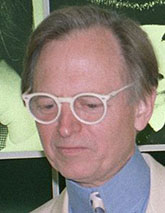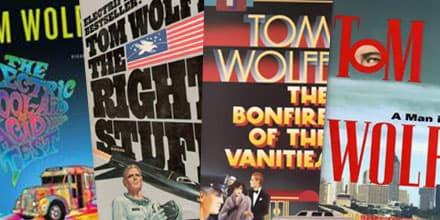Tom Wolfe
Critique • Works • Views and quotes
 TOM WOLFE, 1988 (MoSchle/CC BY 3.0)
TOM WOLFE, 1988 (MoSchle/CC BY 3.0)Tom Wolfe
Born
Richmond, Virginia, United States, 1930
Died
New York City, United States, 2018
Places lived
Richmond, Virginia, United States; Springfield, Massachusetts; Washington, D.C.; New York City
Nationality
American
Publications
Novels, journalism, essays
Genres
Literary, new journalism
Writing language
English
Literature
• Bonfire of the Vanities (1987)
Novels
• Bonfire of the Vanities (1987)
• A Man in Full (1998)
American Literature
• Bonfire of the Vanities (1987)
• A Man in Full (1998)
The new novelism and the ever-passing now
"Deep down he's really shallow" might have been invented for Tom Wolfe's detractors to throw at him.
His work was crammed with references to surface appearances, clothing styles, cultural bric-a-brac and even commercial brand names. The minutiae of modern life not only filled his descriptive paragraphs but dominated the inner lives of his characters. Deep down, people were really petty, grasping, self-serving narcissists in love with their own images reflected in the culture.
But, the thing is, Tom Wolfe did have an uncanny ability to show people's lives this way. Perhaps "show" is the wrong word. He took the reader on the ride with the characters, whether it was with the good old boys (a phrase Wolfe popularized) of the southern United States in "The Last American Hero is Junior Johnson. Yes!", an article in his first non-fiction collection, or it was in the urbane worlds of Wall Street, Park Avenue and Harlem in The Bonfire of the Vanities, his first novel two decades later.
Note the similarity between his fiction and non-fiction. For years Wolfe was known as the exemplar of New Journalism, which in America meant a breaking down of the barriers between the two forms. Wolfe claimed to have invented the new style almost accidentally. Story goes he got stuck while writing a magazine article about California's hot rod and custom-car building craze in the early sixties. His editor asked him to send his notes and he sat up most of a night typing out all his impressions without regard for conventional journalistic form. The editor ran the mix of reportage and subjectivity as it was, under the title "There Goes (Varoom! Varoom!) That Kandy-Kolored (Thphhhhhh!) Tangerine-Flake Streamline Baby (Rahghhh!) Around the Bend (Brummmmmmmmmmmmmmm)...".
So was born the New Journalism. The story was collected with similarly creative pieces on pop culture in The Kandy-Kolored Tangerine-Flake Streamline Baby (1965), which became a sensation.
It was followed in 1968 by more of the same in The Pump House Gang and a book-length account of author and LSD-advocate Ken Kesey's adventures in The Electric Kool-Aid Acid Test. Many consider the latter Wolfe's best nonfictional work. For anyone interested in the mixed-up, exciting era of the 1960s, The Electric Kool-Aid Acid Test still holds up as an insightful exploration of some of the origins of the creativity and craziness of that time. Wolfe's sometimes strange syntax and typography appear as outdated avant garde affectations now, but the artistic experiments succeed in helping get inside a social phenomenon better than more prosaic writers have managed to do.
By this time other American writers, like Hunter S. Thompson (Hell's Angels, 1967; Fear and Loathing in Las Vegas, 1971) and Norman Mailer (The Armies of the Night, 1968; Of a Fire on the Moon, 1970), were getting in on the act, using novelistic techniques in journalism. However they seemed to inject more of themselves into the stories than Wolfe did, bringing the reader into their own chaotic thoughts and feelings as they explored social landscapes. Wolfe endeavoured rather to present the minds of his characters. Or at least to present the impression that he was doing so. Nonetheless his point of view could often be determined, usually skewering his subjects, using their own words and behavioural tics.
His 1971 book Radical Chic & Mau-Mauing the Flak Catchers was controversial for exposing wealthy liberals as do-gooders manipulated by the black-power radicals of the time. The Painted Word (1975) raised an even bigger storm for its depiction of the New York art world as insular and elitist. The next year he derided an entire generation by labelling the 1970s the "Me Decade" in an article in his book Mauve Gloves & Madmen, Clutter & Vine.
A more positive and substantial work was his 1979 story of the rivalry between rocket test pilots and astronauts during the early space program, The Right Stuff. It won an American Book Award, among other honours, and was made into a successful film of the same name in 1983.
Versus the 'Three Stooges'
Writers, like Mailer, were also experimenting in the opposite direction, applying journalistic techniques to fiction, but Wolfe stuck to nonfiction for more than twenty years. His first serious attempt at a novel was The Bonfire of the Vanities written in 1984 and 1985 as a serial in Rolling Stone magazine with biweekly deadlines. It was finally published in book form in 1987 and was yet another sensation, eventually selling more than three million copies in hardcover and paperback. Bonfire was again set in New York, featuring a range of immoral and amoral characters of the type you read about in the news—greedy brokers, corrupt politicians, crooked lawyers, sensationalist reporters, and self-serving activists. It was adapted for a famously hated film.
His next novel was A Man in Full (1998) about a failing real estate developer, a laid-off warehouse worker, a black lawyer and a white bank executive who eventually come together over an alleged rape case, each trying to fulfill their vision of what it is to be a complete man at the end of the second millennium.
In A Man in Full, Wolfe came closest to evoking the genuine depths, though the weight of trivial detail and a cop-out ending tend to undercut his achievement.
It was Wolfe's thickest, most popular novel, though it drew attacks from critics and other writers—notably Mailer, John Updike and John Irving—for alleged superficiality and journalistic hyperbole.
Since then he produced another non-fiction collection of articles, Hooking Up, (2000), showing off his brilliant research into, and brilliant presentation of, yet another wide variety of American milieus, including the surprising roots of Silicon Valley, academic debates over sociobiology, the sex lives of modern teenagers, and a devastating critique of the supposed irrelevance of literary American novelists—especially his writer critics whom he dubbed "My Three Stooges". The collection also includes a novella, "Ambush at Fort Bragg", based on a subplot excised from A Man in Full.
A third novel, I Am Charlotte Simmons, came out on 2004 to mixed reviews and much lower sales than previous works. A fourth, Back to Blood, was an even worse commercial and critical flop in 2012.
In Wolfe's last years and since his death in 2018 his reputation as a once-important writer has continued to fall.
For one thing, the influence of his early "new journalism" seems to have waned, if not completely disappeared. There's little in today's reporting to show for the wild experimenting of the 1960s and 1970s. Journalism may be less obsessed with pretended objectivity than they used to be, but serious reporters seem to be sticking to the traditional journalistic principles of the pre-Wolfe era. We don't see a lot of stories in the hyperbolic style of Kandy-Kolored Tangerine-Flake Streamline Baby these days.
Nor have the literary innovations of Wolfe's fiction changed writing much. Sardonic accounts of the social scene have been a feature of such great writers as William Thackeray and Charles Dickens, writers Wolfe claimed to emulate, though perhaps he comes closer to Anthony Trollope and Evelyn Waugh. Journalistic styles have been used in the past by writers such as John Dos Passos, whom Wolfe also cites. (See Dos Passos's U.S.A. trilogy for a radical example from the 1930s that far exceeds Wolfe in this). But the bulk of novelists then and now are still writing much as they always have—in their first- and third-person accounts based on personal experience, imagined characters and creative plotting.
Will it last?
To be fair, it's a bit simplistic to say that what Wolfe did was just apply journalistic techniques to fiction. Rather he first applied fictional techniques to journalism and then applied the result of that fusion back to fiction. However, the result may be not to enrich the novel but rather to dilute it. The surface fireworks of journalism are extended down into the depths of the novel, so it is hard to tell whether any depths still exist. The suggestive power of prose is discarded. The mysteries that engage and bedevil us are gone. It's what-you-see-is-what-you-get—all the way down.
Watching Wolfe's early success, writers were bound to be influenced toward his seemingly ripped-from-the-headlines style, but what will make the greatest long-term difference will still be how much readers are moved by the characters and story, whatever style is adopted. Wolfe created a sensation or two, but so far it's not clear his characters or stories stand up as real in their own rights. Are they deeply affecting? Are they important to us? Or are they just superficially complex? Deep down, are they really shallow?
Wolfe aimed to document his time and place. He succeeded at least partially in that. But did he do so, as Thackeray, Dickens, Zola, Tolstoy, Hemingway and other great literary figures did—that is, while creating lasting literature? I'm still wondering. For a number of years his writing was significant and vital in the cultural conversation. Perhaps that's all we needed.
Will anyone care about these stories after the eras they depict have passed? Does that even matter? Or does the future of the novel lie in that it will no longer be written for the future, but rather for an ever-passing now. I mean now. I mean...3..2..1..now. Now! Yes, now!
— Eric
Critique • Works • Views and quotes


